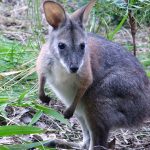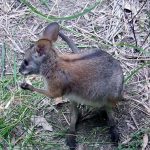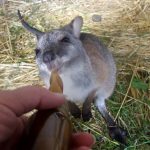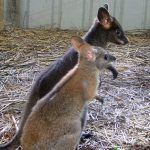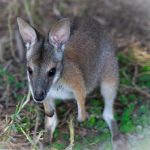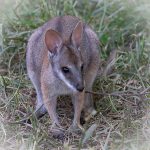BLACK-STRIPED WALLABY
Macropus dorsalis
Conservation status in NSW: Endangered
The Story of the Black-Striped Wallaby
Hidden in Australia’s lush forests with dense undergrowth, a quiet, soft-footed resident once thrived: the Black-Striped wallaby. With a gentle leap and an ever-watchful eye, this shy marsupial has danced through dusk’s golden glow for thousands of years. Today, however, its tale has become one of both wonder and urgency.
Appearance: A Tale Written in Fur
Step quietly through the shadowed bush, and you might glimpse the Black-Striped wallaby. Notice its unique visual signature:
- Females: Slight and nimble at 6–7.5kg and just 65cm tall
- Males: Robust and impressive, up to 18–20kg and stretching to a full 1 metre high
Colour and Markings:
- Coat: Greyish-brown, earthy and soft, blending seamlessly with the forest floor
- Shoulders & Forearms: Tinted with a gentle reddish hue
- Belly: Creamy white, often glimpsed as the wallaby sits or moves
- Signature Black Stripe: Runs from the forehead across the spine, stopping just above the rump – a living brushstroke
- White Hip Stripes: Splashes of pale white on each hip, standing out against the darker fur
Imagine running your hand across the dense pelt, feeling the gradation from the dusted grey to the deep, stark black of its stripe—a masterpiece of camouflage and distinction.
Habitat and Daily Rhythm
The Black-Striped wallaby is a creature of the in-between, nestled between light and shadow:
Preferred Home:
- Dense forests, thick with undergrowth provides crucial shelter
- Open grassy patches serve as foraging grounds at night
Diurnal Patterns:
- By day: Wallabies rest quietly amid low trees or scrub. The filtered sunlight dapples their coats, a mosaic of warm and cool tones.
- By night: Groups, sometimes up to twelve, gather and move with measured grace into open patches, nibbling fresh grasses and sharing a social world only darkness knows.
Home Range:
- While technically spanning up to 90 hectares, most wallabies use just 10–15 hectares, rarely straying more than 300 metres from protective cover, ensuring a swift escape from danger.
Diet: The Grasses of Life
- Primary Food Source:
- Grasses are not simply a meal, but the very heartbeat of the wallabies’ existence. At night, the cool dew settles and scents the ground, offering a feast rich with texture and quiet comfort.
Conservation Concerns
A Vanishing Presence
Not so long ago, these wallabies were a common sight in Central and Southern Queensland and Northern New South Wales. However, with the clearing of forests for cattle, relentless trapping and hunting, and predation by introduced predators, their numbers have plunged drastically.
Table: Changing Status of the Black-Striped Wallaby
| Year | Status | Key Points |
|---|---|---|
| 1991 | Common | Abundant sightings, especially in hidden habitats |
| 2005 | Declining | Populations trapped, shot; loss of ground cover |
| Present | Endangered (NSW) | Listed under the Biodiversity Conservation Act |
Why Are They at Risk?
- Population Decline: Once numbering in the tens of thousands, their presence has dwindled alarmingly.
- Habitat Clearance: Forests cleared for agriculture remove vital undergrowth, leaving wallabies exposed and homeless.
- Specialised Needs: Reliant on specific diets and habitats, adaptation is limited.
- Severe Threats: Loss of habitat and direct human impacts make recovery difficult.
A Sensory Walk in the Forest
Close your eyes and imagine:
- The scent of cool, moist earth at dawn
- The soft crunch of grass underpaw
- The occasional rustle as a cautious wallaby darts for cover
Their world is both fragile and vibrant—a quiet drama played out behind layers of foliage, where every sound and scent is woven into the tapestry of survival.
The Future: Voices for Conservation
The Black-Striped wallaby stands as a living symbol of Australia’s unique biodiversity. Its story asks us to reflect:
- What will vanish if we do not act?
- How can grasslands and forests be protected for creatures who depend on them?
By preserving habitats, restricting harmful activities, and lending our voices to conservation, we ensure that these remarkable wallabies continue their age-old journey through Australia’s wild places.
Take Action: Every Step Counts
- Learn more about your local wildlife and their needs
- Support conservation groups and efforts for habitat protection
- Share stories—awareness leads to action
In the quiet shimmer of the Australian dusk, the future of the Black-Striped wallaby depends on the choices we make today. Let us carry their story with care, and with hope.


